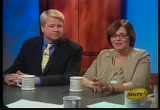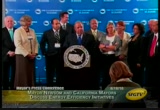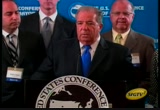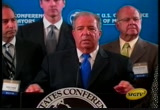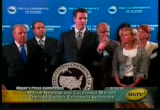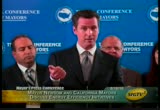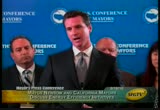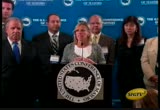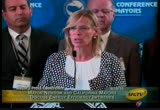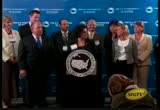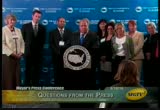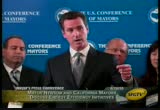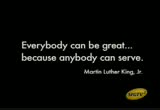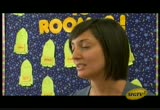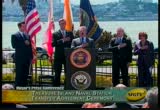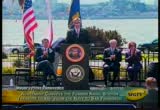tv [untitled] September 21, 2010 10:00pm-10:30pm PST
11:02 pm
>> i want to thank you all for being here today. i'm the mayor of the city of long beach, california, and i'm also a trustee of the u.s. conference of mayors. mayors from all over this great state have assembled here today to talk about the energy efficiency conservation block grant program. this is a program that started in 2007, and it delivers funds directly to cities to be able to improve their energy efficiency, reduce their carbon footprint, and as important, create new jobs in our community.
11:03 pm
i will just give you a little background in this really quickly. program was originally thought of in 2005 when the u.s. conference of mayors launched its climate protection agreement. the agreement is a landmark measure across the country. the u.s. conference of mayors initiated it. it began with 141 mayors. it now has 1044 mayors that have signed on to the climate protection agreement, committing to reduce our climate footprint in each one of our communities. the energy block grant program has been an integral part of that. it gives us the resources to reduce our energy consumption and reduce our carbon footprint, and as i said, it also creates jobs. it has been the result of a lot of people working together, but i do need to thank the speaker of the house, nancy pelosi, who worked hard to make this program
11:04 pm
a reality, and we would not be here today except for her efforts. on behalf of american cities, i want to thank the speaker for her commitment and diligence. without her help, as i said, this would not be here. i also want to thank president obama and his administration for his support of the program as well as the american recovery and reinvestment act, which is also to fund a number of new initiative projects in a number of our cities. as i said, we are here to work for efficiency and reduce our carbon footprint. in my city, we are investing about $4 million to accelerate private city efforts to reduce energy efficiency in our city structures as well as some of our residential buildings, and we will hear in a moment from the mayors of other cities about what they're doing, but this program is exactly what we need to continue. it is really the only major funding source we have to be
11:05 pm
able to improve our efficiency and work on climate change issues, particularly by reducing our carbon footprint. we know that a successful plan for reducing u.s. energy consumption is grounded in local action, and all across this country, it has been demonstrated that local government can take action that is effective and not only reduces our impact on the environment but also puts people back to work. we have been leading the nation in this effort, and i have to tell you, it has been an innovative program that provides the flexibility needed to local governments, and it is the kind of thing that must be carried on in the future. i now would like to introduce a friend of mine and no stranger to all of you, san francisco mayor gavin newsom, who is going to discuss what things have been going on right here in san francisco with this program. mayor newsom: thank you for your stewardship and leadership in bringing us all together.
11:06 pm
i thank all the mayors that are here and all of you for taking the time to be here. from our perspective, there are few things more important than this. at the end of the day, what we are really talking about, what we are organizing around is job creation and economic development, reducing the costs not only to government, but reducing the cost to individual businesses, large and small, that want to reduce their energy bill at the same time we advance our environmental principles and advance our collective goals. as many of you know, san francisco has a low global climate action plan. basically all that is is the formal plan that 3043 other mayors -- at 1043 other mayors have signed to robot greenhouse gas unless it -- emissions to 1990 levels by 2012.
11:07 pm
we have done that through -- in small part in terms of that reduction. that is energy efficiency. that is the low hanging fruit. that is the easy part of this effort. we have some very ambitious goals nationwide. about half of that, most objective analysis has been done that shows that half of that can be achieved through energy efficiency, so you do not need something in the order of magnitude. just common sense. swapping out that level, taking the old boiler and replacing it, taking that call don t --hat -- that caulk gun in different respects. the think about it is it is so obvious and so easy but we were not achieving our goals until the president and speaker got
11:08 pm
together and demanded we get some block grants. we needed some energy development block grants and we needed some autonomy. let me conclude by making a jobs case, and i was making this just a moment ago, on why this matters. we get about $7.7 million through block grants, and we are using that jobs now program, the federal subsidy for direct jobs. 3600 jobs we have created. they are going out and doing energy audits, so we are doing free energy audits, and then we are using all these grants, and then we are providing free resources for folks to actually deal with their boilers and other issues, but here is the big idea, and this is something -- if we put $1 billion -- you do not need to take $1 billion
11:09 pm
credit. you can just leverage the percentage that is arguably of to what $1.8 trillion that is just sitting there on the sidelines. just to leverage that money is guaranteed, like we do small business association loans, and start getting people to work today on energy efficiency and create real jobs. here's how we do it -- you get $1 billion just making this case, and you invest into coal, and generate about 870 jobs. sounds great, but you could generate 1000 or 1500 jobs in nuclear energy, but if you want to create more jobs and wealth and opportunity, 1900 jobs in wind or about 3300 jobs, but the big game changer is retrofitting and green building. 7000 jobs for that $1 billion investment. you can just use the money that is sitting in all these
11:10 pm
financial institutions and guarantee those loans and get people back to work, doing the energy efficiency work that all these mayors are doing quite successfully, and you do it in rural and suburban areas, not just these big metro areas. get people to work, particularly those in the building and construction trades, those that have the highest rate of unemployment. that is the opportunity, and that is where we are trying to communicate, what we are trying to organize around. this is a win on all fronts, and this is being demonstrated in cities large and small across the country. one of the successes of the stimulus plan is the focus on jobs and this economy. i want to thank everybody who is here and think cathy and her team for their leadership, and think mayor foster for helping bring all of you here to our city and county of sentences go.
11:11 pm
thank you. >> thank you, mayor newsom. >> i would like to bring our partner to the podium, the efficiency secretary, cathy joey. >> thank you all for coming. three quick points. on behalf of the president and secretary chu, let me underscore that energy efficiency is central to economic recovery from our perspective. we need to bleed into all the energy potential. americans spend $1.10 trillion on utility bills in their businesses and homes per year. we can become more efficient. that is $200 billion we can save, and we can create jobs while doing it. for every billion that gets invested, 7000 jobs. this program will go on to create more. we love our partnership with the mayors.
11:12 pm
the mayors are working directly in investing money in cities on the ground, in buildings, schools, and communities. this program has 2350 grantees from across america that have programs under way this summer, demonstrating that investments in clean energy, green energy, helps economies. watch where the projects are. some of them are wildly innovative. some just make good sense. there are sensible, money saving light bulbs that should have gone in a long time ago. putting new elie de -- led technology into traffic lights, which create safer streets. there are literally thousands of projects under way. take note of what those are. share information. in washington, we are very excited about our partnership. we are very excited about the
11:13 pm
energy savings that will come from this program and in the future. thank you all. >> thank you, madam secretary. finally, we will have another major address you with what is going on in her city. she is from the city of santa barbara. >> thanks you. i appreciate the opportunity to speak here. i think mayor newsom for your leadership from the beginning. hopefully, we can see some allocations after the first- round is moved around. that is important for congress to see the investment of this as not just an expenditure. the city of santa barbara has a little over 100,000 people. our funding was about $658,000. we did lighting efficiency projects in four parks as well as some heating, ventilating, and air-conditioning retrofits in eight city buildings. the park's alone are saving
11:14 pm
140,000 kilowatt hours annually, a savings of $88,000. the eecbg grants, coupled with other funding we did with our municipal building energy audit, is sitting as $150,000 in our general fund. along with the jobs that are being created with this project, when i came in and met with a number of mayors this morning, the first question has been how is your budget going. what is going on with your general fund and your public works? in our city, if we are able to save $150,000 a year that would have gone to paying for energy bills, which can put it into police officers, firefighters, parks and recreation -- the municipal services people have come to expect. that is helping us get over this recession on top of giving private-sector jobs. it is saving energy at the same
11:15 pm
time. it is a great program. we need to keep it coming to the cities. i appreciate the leadership of the u.s. conference of mayors for having this meeting today. >> thank you, mayor schneider. are there any questions from anyone? >> i was just wondering about -- speaking of leveraging grants, clean energy loans. can some of that money come to this program? >> can you repeat that? i did not get all of that. i am sorry. >> we just passed with a lot of fanfare and no follow-up, not because of good intentions but because of fannie and freddie. i was going to use the wrong adjective. [laughter] their unwillingness to be
11:16 pm
supportive of the program -- they are wrong. this is right. the president is right. congress, by and large, is right. all these mares are ready to go to do what -- all these mares are ready to go to do what the secretary started. the first program was done in berkeley years ago. it is simple. the company is not going to provide enough resources. how the finance those upgrades? -- how do you finance those upgrades? you can amortize them over the life of your mortgage in a way that gives billions of dollars for the retrofitting of buildings. ours is the largest in the united states. we passed a more than $150 million appropriation. we were ready to go. we had dozens of people who had
11:17 pm
already gotten approval. then the word came out that fannie and freddie no longer would allow these because of the weight it relates to first orleans. i will not bore you with it. -- because of the way it relates to first liens. i will not bore you with it. it is a step to the screen economy. it is up to the folks running fannie and freddie. we need to see something change quickly. our attorney general filed suit, to his credit. mayors across the country are ready to voice, as well as governors, when we have a sympathetic ear from the administration and the department. we just need some folks there to right this wrong. >> any other questions? thank you all for being here. we appreciate it.
11:26 pm
gentlemen. welcome to a gorgeous day on treasure island. in the redevelopment director of the treasure island authority. would you please rise for the singing of the national anthem? >> ♪ o, say, can you see by the dawn's early light what so proudly we hail at the twilight's last gleaming whose broad stripes and bright stars through the perilous fight o'er the ramparts we watched were so gallantly streaming and the rockets' red glare
11:27 pm
11:28 pm
be here today on treasure island with the honorable speaker of the united states, house of representatives, nancy pelosi. [applause] the honorable secretary of the navy, ray davis. [applause] and the honorable mayor of the city and county of san francisco, gavin newsom. [applause] today we stand on the brink of the future of this island by commemorating the historic agreement with the transfer of the formal the -- naval station from a united states navy to the city and county of san francisco. i know i speak for many people who have worked extremely hard to make this day a reality, people on all sides of the table, across organizations, when i say that it is truly an honor and a proud moment.
11:29 pm
i would like to take a moment to acknowledge our many partners and supporters who are here today. please forgive me if i do not mention everyone. there are too many of you to name individually, but i would like to recognize, and if you would please stand, former mayor willie brown, current and past members of the treasure island development authority board of directors. our treasure island citizens advisory board, and the treasure island homeless development initiative, one of our great partners, and of course, our private sector partners, the treasure island community development.
85 Views
IN COLLECTIONS
SFGTV2: San Francisco Government Television Television Archive
Television Archive  Television Archive News Search Service
Television Archive News Search Service 
Uploaded by TV Archive on

 Live Music Archive
Live Music Archive Librivox Free Audio
Librivox Free Audio Metropolitan Museum
Metropolitan Museum Cleveland Museum of Art
Cleveland Museum of Art Internet Arcade
Internet Arcade Console Living Room
Console Living Room Books to Borrow
Books to Borrow Open Library
Open Library TV News
TV News Understanding 9/11
Understanding 9/11